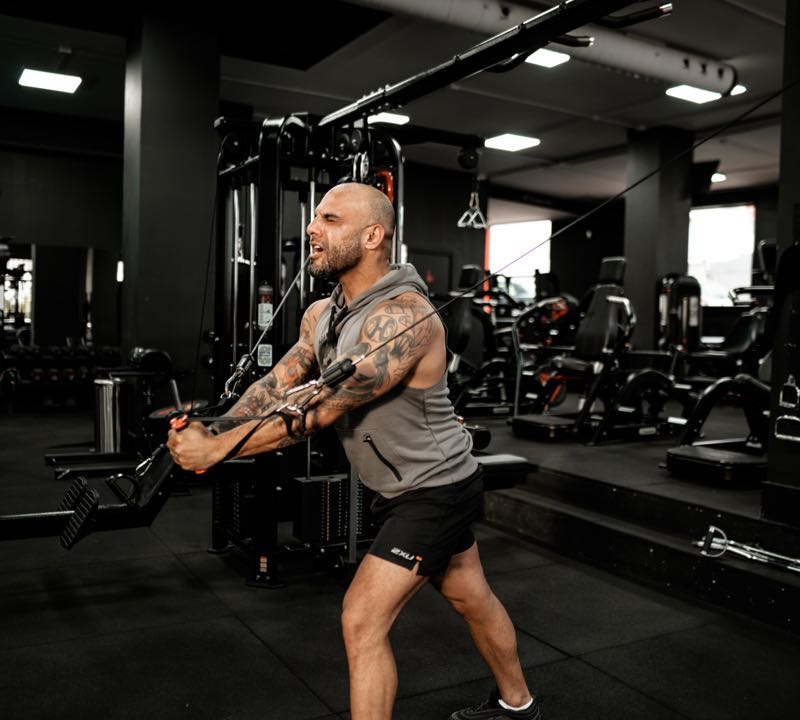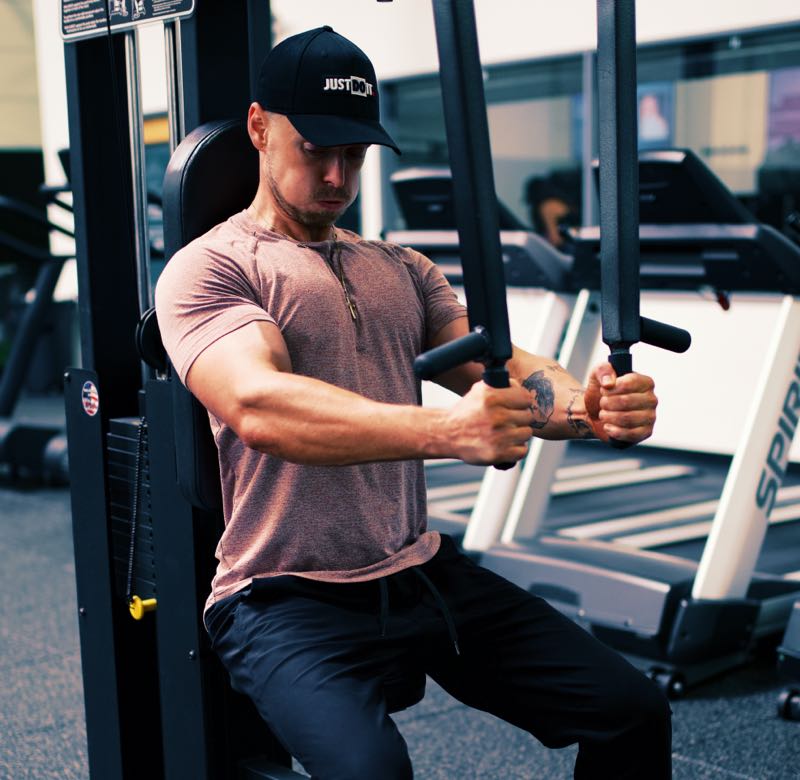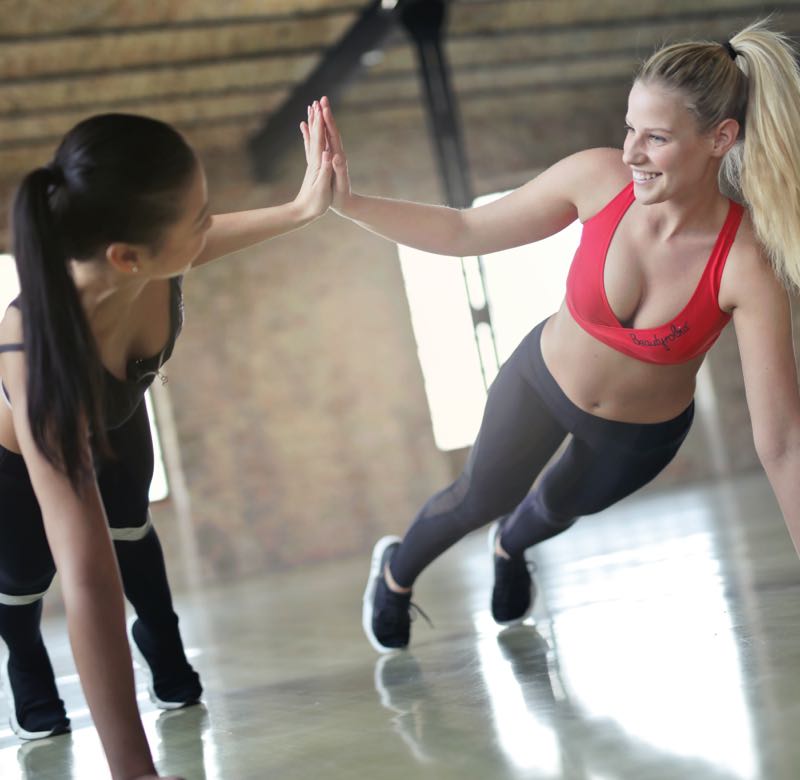This quick workout takes less than 20 minutes and can be done almost anywhere. You’ve got two goals: Maximize your calorie burn, Train your fitness for more intensity, High Intensity Interval Training (HIIT) maximizes your calorie burn by keeping your heart rate high enough during the workout that your body burns calories long after you’re done exercising.
This workout pushes your upper body, lower body and core with high intensity so you get the benefits of high-performing cardio with an all-over body benefit that’ll make you jump for joy.
1. Air Squats
Start with your feet shoulder width apart, toes facing forward or slightly turned out. Make sure that your core is braced, chest up, eyes forward. Start by lowering your butt to knee height (or below if comfortable), your knees should track over toes. Drive through your feet to return to standing position.
The goal: Perform the move for 30 seconds, and then rest for 15 seconds.
2. Push-ups
Start with your hands on the floor outsides of your chest, fingers forward, elbows inward to 45 degrees. Your feet should be hip width apart, core tight, and be sure to squeeze your glutes. Keep your eyes down, long, flat back in a straight line from your head to your heels. Begin to lower your chest to floor, and then push through your hands to lift your upper body back to starting position.
The goal: Perform the move for 30 seconds, and then rest for 15 seconds
3. Mountain Climbers
Start with your hands on the floor, stacked under elbows and shoulders, fingers forward. Your feet should be hip width apart, core tight, squeeze glutes. Keep your eyes down, long, flat back in a straight line from your head to your heels. Alternate driving one knee in towards your chest at a time, extending that same leg, and then switching to the other side and repeating.
The goal: Perform the move for 30 seconds, rest for 15 seconds.
Prioritizing frequent, intense workouts while neglecting rest days can not only lead to diminishing performance returns with your fitness, but can also leave you open to injury, fatigue, or burnout, as SELF recently reported.
“
The more intense the workout, the more important the warm-up is. It’s kind of like prepping your nervous system as well. If your body is not ready for that work, the outcome could be injury, or your performance can suffer.
John Doe Tweet
Limit your HIIT to one or two workouts a week, and make sure you’re balancing them with plenty of easy workouts—as well as at least one straight recovery day per week.

Can you build muscle with smaller weights?
It can be hard to work out with so many distractions and difficulties keeping us from the gym. When we are able to work out, focusing on the exercise and blocking out distractions can be even harder. Too often, we power through a workout and check it off the list without thinking about how to improve mental health. So how do we bust through the distractions to get the most out of our workouts? Expert say without a mindful approach to a workout, we risk poor results or even injury. Mindfulness includes paying attention to how you’re breathing – and to an extent – even controlling it. Breathing exercises improve your mental health, too. Use these three easy-to-remember techniques to maximize your breathing before, during and after you exercise. Before: Set a Clear Intention Set an intention for your workout, given the time and space you have available. Example intentions could be to make sure you’re breathing during stressful moments or to savor your rest periods by being fully present in your breath. If you only have 30 minutes, position your workout accordingly and set the intention clearly. Revisit that intention regularly throughout your workout. Take a moment before you begin to check in with your body through breathwork. Focus on your inhale and see where the breath moves easily in your body. “Are you tensing in certain areas?” asks Tory. “Then you might be tight there. Pay attention to what your body is telling you and apply that to your workout.” If you want to improve mental health, it begins with paying attention. During: Use Your Breath as a Guide Be aware of your breath as you exercise. If your inhales and exhales shorten and quicken, that is a response to the work your body is doing. “If you’re bracing or holding your breath, you may be overexerting yourself,” says Tory. Using your breath correctly will reduce stress, help guide your workout and improve mental health. If you’re working out with a partner, you can use the you-go-I-go technique. “As your partner exercises, you can recover with intentional breathing, slowing down your heart rate. With partner exercises, synchronize your movements and your breaths,” Tory. “This will accentuate and strengthen the emotional connection between you.” After: Recover with Rhythmic Breathing Speed up recovery by incorporating breathing exercises with your stretching routine. “Focus on the areas that you stressed during the workout,” says Tory, “Breathe into the stretch and open up that tissue.” The goal is to get to a relaxed state, returning to rhythmic nasal breathing as soon as possible. By sealing your lips and focusing on breathing through your nostrils, your body will get the cue to relax through the rhythm of repetition. https://www.youtube.com/watch?v=TFO9hBtLVec&feature=emb_logo Consistency is more important than perfection. If you want to improve mental health, you don’t have to make drastic changes to your entire routine, just start incorporating mindfulness and breathwork into your existing routine. “ The smaller the change, the more sustainable it will be. Don’t tell yourself you will be mindful at every minute of your workout. You’re going to get distracted. Just keep coming back to your breath. John Doe Tweet Now that it’s in your toolkit, you can return to mindful breathing any time as another way build on your fitness, both physical and mental. So just breathe.

5-Minute Stress Reliever Bodyweight Workout
Health experts warn that a lingering effect of the coronavirus pandemic could be a mental health crisis. While therapy and medications for stress and anxiety are often necessary, the foods you eat can also play a role in your well-being. An American Psychiatric Association poll released in March found that 36% of Americans felt the existence of the COVID-19 pandemic was having a serious impact on their mental health. People were most worried about their finances, the risk of themselves or a family member contracting the virus, and the possibility of becoming seriously ill or dying. The gut-brain connection The gut has been called the “second brain.” And we recognize the link between the two even if we don’t realize it: You may feel “butterflies in your stomach” when you’re nervous or “go with your gut” when you make an important decision. Naidoo said the two are connected physically and biochemically via the gut-brain axis, the complex communications network that links the emotional and cognitive centers of the brain with intestinal functions. Foods that can hurt mental health Fried foods, processed foods, trans fats, nitrates and foods high in salt, saturated fat and refined sugars can worsen depression, anxiety and stress. “If you’re eating processed foods and fast foods every day, that’s basically making the bad gut bacteria thrive, and that’s when you start to run into problems with inflammation,” Naidoo explained. Too much caffeine and alcohol may also make you feel worse mentally but are usually OK in moderation. Drinking 400 mg per day or less of coffee shouldn’t have an impact on anxiety, Naidoo said. People respond to alcohol intake differently, but generally, four drinks a day for men and three for women is considered heavy drinking. How to start eating for your mental health To shift your diet with mental health in mind, Naidoo suggests starting small. Trying to change too much too fast can be overwhelming and diminish results. “Slow and steady change over time will start to build that healthy gut and basically start to build on the healthy nutrients that are good for your brain,” she said. Begin with a diet self-check. Write down what you ate over the past 24 to 48 hours, circle the foods that are unhealthy, and then decide on one simple change you can make. You don’t necessarily have to give up some of your favorite less-than-healthy foods, though. https://www.youtube.com/watch?v=CdRb8eX2Yns Taking steps to improve your diet for your mental health is especially important today, she said, as the effects of the pandemic will persist. Concerns over jobs, finances, food insecurity, gaps in children’s education and more will take a toll. “ A healthy diet can help mitigate or buffer one from these types of effects as it sets the stage for a beneficial gut microbiome and less inflammation, both of which are tied to mood, anxiety, depression and even sleep. John Doe Tweet Begin with a diet self-check. Write down what you ate over the past 24 to 48 hours, circle the foods that are unhealthy, and then decide on one simple change you can make. You don’t necessarily have to give up some of your favorite less-than-healthy foods, though.

How to Work Out (Safely) with a Friend
Did you know that more than 40% of participants drop a fitness course shortly after it begins if they attend on their own? But if they work out with a friend, the dropout rate decreases to 6%. This suggests that one of the best reasons for exercising with friends is the social interaction. People who train together form a group identity and no longer feel alone. When you accomplish something on your own, of course, it’s amazing. Sharing your successes with your friends who know how hard you’ve worked to conquer your inner couch potato feels even better. It’s more fun exercising with a friend You’re less likely to get bored when you have a workout buddy, especially a friend. While you’re catching up, having a laugh, encouraging each other, you’re also getting healthier. It’s a win-win. Chatting to a friend during exercise and breaks can help time pass quickly too. You’ll have more options as well, such as a game of tennis or squash. You’re stick to your commitment If you’ve arranged to meet a friend for a walk or booked an exercise class, you’re more likely to keep that commitment. Not wanting to let your friend or exercise partner down can be a great motivator to show up. And as your exercise becomes routine, perhaps after a few weeks, you’ll both find it less challenging and will more likely stick to your commitment. On those days when you don’t feel like exercising, a pep talk from your workout buddy might be just the lift you need. You can support each other. It’s safer to exercise with someone else Having someone to spot you when you’re lifting weights (that is, someone ready to support you, if need be), or to go running with you, especially at night, means you have help at hand if anything goes wrong. Start with friends and family who live nearby, or maybe your neighbour or a work colleague. Suggest a daily or weekly workout date, and make the commitment, helping each other along the way to achieve goals. https://www.youtube.com/watch?v=TFO9hBtLVec&feature=emb_logo On those days when you don’t feel like exercising, a pep talk from your workout buddy might be just the lift you need. You can support each other. “ Having someone to motivate you can make all the difference to achieving your goal. In fact, research has found that people are more likely to lose weight if their exercise buddy is losing weight. Bonus! John Doe Tweet If you’ve arranged to meet a friend for a walk or booked an exercise class, you’re more likely to keep that commitment. Not wanting to let your friend or exercise partner down can be a great motivator to show up.
follow
Error: No feed with the ID 2 found.
Please go to the Instagram Feed settings page to create a feed.

